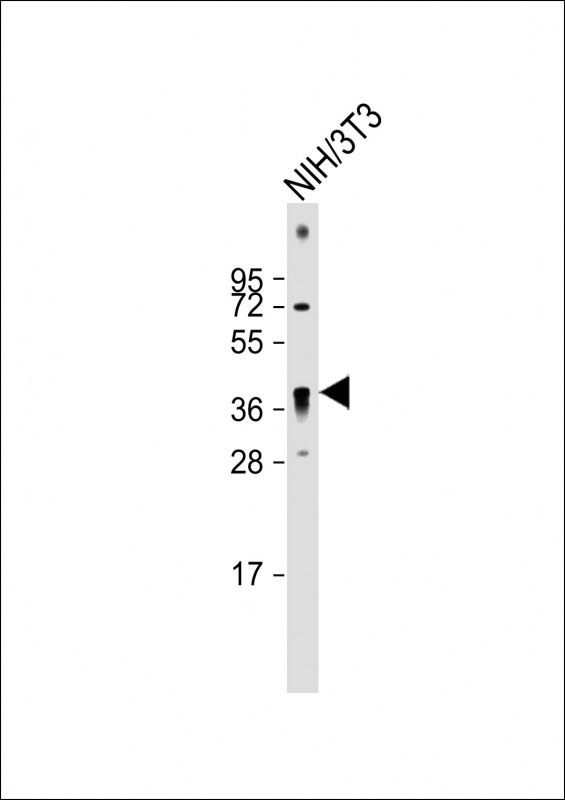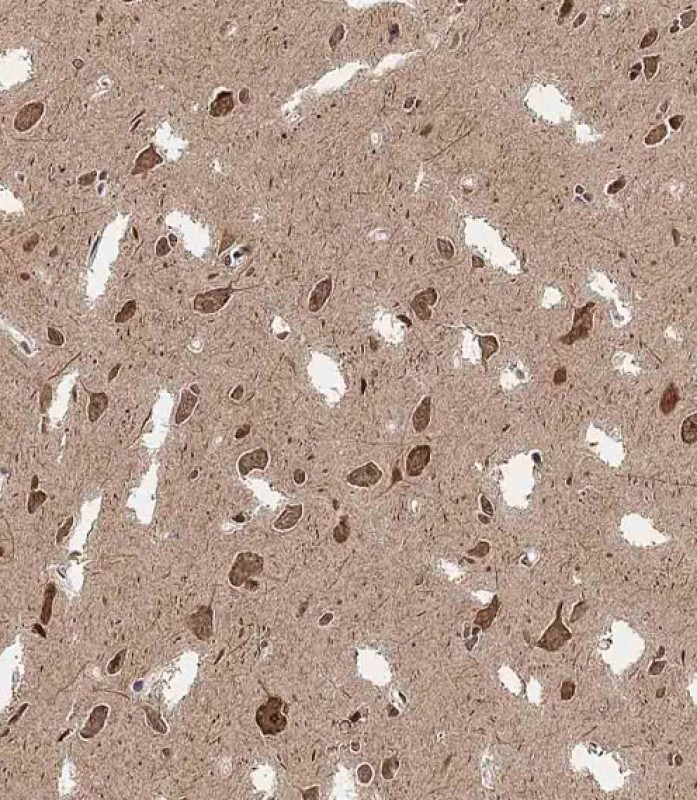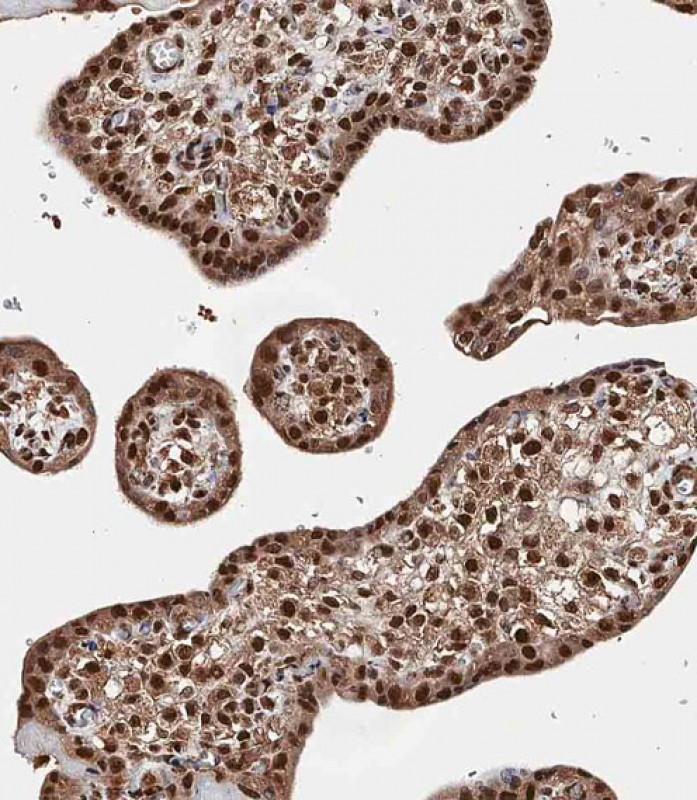QKI Antibody (N-term)
Affinity Purified Rabbit Polyclonal Antibody (Pab)
- SPECIFICATION
- CITATIONS
- PROTOCOLS
- BACKGROUND

Application
| IHC-P, WB, E |
|---|---|
| Primary Accession | Q96PU8 |
| Other Accession | Q5W9D5, Q9QYS9, Q5W9D7, Q6P104, Q32NN2, Q5W9D6 |
| Reactivity | Human, Mouse |
| Predicted | Xenopus, Zebrafish, Bovine, Horse, Pig |
| Host | Rabbit |
| Clonality | Polyclonal |
| Isotype | Rabbit IgG |
| Calculated MW | 37671 Da |
| Antigen Region | 1-30 aa |
| Gene ID | 9444 |
|---|---|
| Other Names | Protein quaking, Hqk, HqkI, QKI, HKQ |
| Target/Specificity | This QKI antibody is generated from rabbits immunized with a KLH conjugated synthetic peptide between 1-30 amino acids from the N-terminal region of human QKI. |
| Dilution | IHC-P~~1:100 WB~~1:2000 E~~Use at an assay dependent concentration. |
| Format | Purified polyclonal antibody supplied in PBS with 0.09% (W/V) sodium azide. This antibody is purified through a protein A column, followed by peptide affinity purification. |
| Storage | Maintain refrigerated at 2-8°C for up to 2 weeks. For long term storage store at -20°C in small aliquots to prevent freeze-thaw cycles. |
| Precautions | QKI Antibody (N-term) is for research use only and not for use in diagnostic or therapeutic procedures. |
| Name | QKI {ECO:0000303|PubMed:16342280, ECO:0000312|HGNC:HGNC:21100} |
|---|---|
| Function | RNA reader protein, which recognizes and binds specific RNAs, thereby regulating RNA metabolic processes, such as pre-mRNA splicing, circular RNA (circRNA) formation, mRNA export, mRNA stability and/or translation (PubMed:22398723, PubMed:23630077, PubMed:25768908, PubMed:27029405, PubMed:31331967, PubMed:37379838). Involved in various cellular processes, such as mRNA storage into stress granules, apoptosis, lipid deposition, interferon response, glial cell fate and development (PubMed:25768908, PubMed:31829086, PubMed:34428287, PubMed:37379838). Binds to the 5'-NACUAAY-N(1,20)-UAAY-3' RNA core sequence (PubMed:23630077). Acts as a mRNA modification reader that specifically recognizes and binds mRNA transcripts modified by internal N(7)-methylguanine (m7G) (PubMed:37379838). Promotes the formation of circular RNAs (circRNAs) during the epithelial to mesenchymal transition and in cardiomyocytes: acts by binding to sites flanking circRNA-forming exons (PubMed:25768908). CircRNAs are produced by back- splicing circularization of pre-mRNAs (PubMed:25768908). Plays a central role in myelinization via 3 distinct mechanisms (PubMed:16641098). First, acts by protecting and promoting stability of target mRNAs such as MBP, SIRT2 and CDKN1B, which promotes oligodendrocyte differentiation (By similarity). Second, participates in mRNA transport by regulating the nuclear export of MBP mRNA (By similarity). Finally, indirectly regulates mRNA splicing of MAG pre- mRNA during oligodendrocyte differentiation by acting as a negative regulator of MAG exon 12 alternative splicing: acts by binding to HNRNPA1 mRNA splicing factor, preventing its translation (By similarity). Involved in microglia differentiation and remyelination by regulating microexon alternative splicing of the Rho GTPase pathway (By similarity). Involved in macrophage differentiation: promotes monocyte differentiation by regulating pre-mRNA splicing in naive peripheral blood monocytes (PubMed:27029405). Acts as an important regulator of muscle development: required for the contractile function of cardiomyocytes by regulating alternative splicing of cardiomyocyte transcripts (By similarity). Acts as a negative regulator of thermogenesis by decreasing stability, nuclear export and translation of mRNAs encoding PPARGC1A and UCP1 (By similarity). Also required for visceral endoderm function and blood vessel development (By similarity). May also play a role in smooth muscle development (PubMed:31331967). In addition to its RNA-binding activity, also acts as a nuclear transcription coactivator for SREBF2/SREBP2 (By similarity). |
| Cellular Location | Nucleus. Cytoplasm [Isoform QKI6]: Cytoplasm, cytosol. Nucleus Note=Localizes predominantly in the cytoplasm and at lower levels in nucleus. |
| Tissue Location | Expressed in the frontal cortex of brain. Down- regulated in the brain of schizophrenic patients |

Thousands of laboratories across the world have published research that depended on the performance of antibodies from Abcepta to advance their research. Check out links to articles that cite our products in major peer-reviewed journals, organized by research category.
info@abcepta.com, and receive a free "I Love Antibodies" mug.
Provided below are standard protocols that you may find useful for product applications.
Background
QKI belongs to a family of RNA-binding proteins that have an HNRNPK homology (KH) domain embedded in a 200-amino acid region called the GSG domain. Other members of this family include SAM68 (KHDRBS1) and SF1.
References
Zhao,L., J. Neurosci. 26 (44), 11278-11286 (2006)
Haroutunian,V., Am J Psychiatry 163 (10), 1834-1837 (2006)
Aberg,K., Proc. Natl. Acad. Sci. U.S.A. 103 (19), 7482-7487 (2006)
If you have used an Abcepta product and would like to share how it has performed, please click on the "Submit Review" button and provide the requested information. Our staff will examine and post your review and contact you if needed.
If you have any additional inquiries please email technical services at tech@abcepta.com.













 Foundational characteristics of cancer include proliferation, angiogenesis, migration, evasion of apoptosis, and cellular immortality. Find key markers for these cellular processes and antibodies to detect them.
Foundational characteristics of cancer include proliferation, angiogenesis, migration, evasion of apoptosis, and cellular immortality. Find key markers for these cellular processes and antibodies to detect them. The SUMOplot™ Analysis Program predicts and scores sumoylation sites in your protein. SUMOylation is a post-translational modification involved in various cellular processes, such as nuclear-cytosolic transport, transcriptional regulation, apoptosis, protein stability, response to stress, and progression through the cell cycle.
The SUMOplot™ Analysis Program predicts and scores sumoylation sites in your protein. SUMOylation is a post-translational modification involved in various cellular processes, such as nuclear-cytosolic transport, transcriptional regulation, apoptosis, protein stability, response to stress, and progression through the cell cycle. The Autophagy Receptor Motif Plotter predicts and scores autophagy receptor binding sites in your protein. Identifying proteins connected to this pathway is critical to understanding the role of autophagy in physiological as well as pathological processes such as development, differentiation, neurodegenerative diseases, stress, infection, and cancer.
The Autophagy Receptor Motif Plotter predicts and scores autophagy receptor binding sites in your protein. Identifying proteins connected to this pathway is critical to understanding the role of autophagy in physiological as well as pathological processes such as development, differentiation, neurodegenerative diseases, stress, infection, and cancer.




